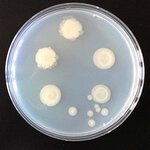Microbiology

A new study has found that not only does fish skin resemble the gut morphologically, but key components of skin immune responses are also akin to those of the gut.
Fish skin is unique in that it lacks keratin, the fibrous protein found in mammalian skin that provides a barrier against the environment. Instead, the epithelial cells of fish skin are in direct contact with the immediate environment: water. Similarly, the epithelial cells that line the gastrointestinal tract are also in direct contact with their immediate milieu.
The results not only are of interest on the level of…

Scientists have developed a strain of the Middle East respiratory syndrome coronavirus (MERS-CoV) that could be used as a vaccine against the disease, according to an upcoming paper.
Since MERS was first identified in June 2012, the World Health Organization has been notified of 108 cases of infection, including 50 deaths. Although the total number of cases is still relatively small, the case fatality rate and the spread of the virus to countries beyond the Middle East is alarming to public health officials. If the virus evolves the ability to transmit easily from person to person, a much…

Tracing the transmission of individual strains from agricultural environments to humans through the food system is difficult because of the rapid evolution of resistance patterns in these bacteria. Resistance patterns change so quickly that it has been impossible to determine where some highly resistant strains are coming from.
Every year in the United States, the various strains of Salmonella together are responsible for an estimated 1 million illnesses, 20,000 hospitalizations and 400 deaths at an economic cost exceeding $3 billion. Salmonella Typhimurium accounts for at least…

Breast-feeding is back. When it comes to early establishment of gut and immune health for babies, 'breast is best' according to a new study of how 'good' bacteria arrive in babies' digestive systems.
How babies acquire a population of good bacteria can also help to develop formula milk that more closely mimics nature.
The researchers found the same strains of Bifidobacterium breve and several types of Clostridium bacteria, which are important for colonic health, in breast milk, and maternal and/or neonatal faeces. Strains found in breast milk may be involved in…

12.00
A study released on Monday found a link between induced or
augmented labor, that is, the use of Pitocin, and autism.
Women whose doctors decided to begin labor by administering
Pitocin, an artificial form of oxytocin, or to speed up contractions with
Pitocin were up to 23 percent more likely to have children diagnosed with autism
spectrum disorder.
Sorry I can't find a link to the actual study yet. Read
more: http://healthland.time.com/2013/08/13/induced-labor-linked-to-higher-autism-risk/#ixzz2bs2jhpuR
Researchers matched the birth records for 625,000 babies in
North Carolina over an…

Cleaner drinking water with fewer chemicals may be made possible using ... bacteria.
A research team studied four bacteria, Sphingobium, Xenophilus, Methylobacterium and Rhodococcus, found in a city's drinking water to see which combinations were more likely to produce a 'biofilm'. Biofilms are layers of bacteria which form on the inner surfaces of water pipes. Like in many instances, bacteria can be harmful or not.
"If the bacterial growth is too heavy, it can break off into the water flow, which at best can make water discoloured or taste unpleasant and at worst can release more…

In 2011, a paper revealed that Dictyostelium discoideum, a single-celled organism, picks up edible bacteria, carries them to new locations and harvests them like crops - basically, it is the world's smallest farmer. (Nature 469, 393-396 doi:10.1038/nature09668)
A closer look at one lineage, or clone, of a D. discoideum farmer carries not one but two strains of bacteria. One strain is the “seed corn” for a crop of edible bacteria, and the other strain is a weapon that produces defensive chemicals. The edible bacteria, the scientists found, evolved from the toxic one. The two strains differ by…

New biological insecticides, which make use of “entomopathogenic” viruses that are harmful to insects, have emerged in recent years. The big advantage versus regular pesticides is that they are innocuous to man, vertebrae and plants, and environmental activists have not heard of them yet. Each viral strain attacks a very limited number of insect species.
The baculovirus is frequently studied and to identify the virus in this family that will most effectively control the Guatemalan potato moth, a French-Ecuadorian research team from Institut de Recherche pour le Développement (IRD) has…
Salmonella bacteria is most frequently spread to humans by infected food and as they develop a resistance to one group of antibiotics they are also less susceptible to killing by other, unrelated antibiotics and a biocide used in common household items.
Researchers have discovered that a common mutation in Salmonella, which makes it resistant to fluoroquinolones, an important class of antibiotics, also allows survival of bacteria in the presence of other antibiotics or the biocide, triclosan. Triclosan is an antibacterial and antifungal agent found in toothpastes, deodorants and soaps.…

Sexual reproduction is costly.
For starters, only half of the population can bear offspring so the other half has to work hard to make sure they're included in the future gene pool.
Yet there is a payoff beyond the sex jokes sure to follow that statement. Sexual reproduction allows the mixing of parental genomes to generate potentially beneficial new combinations of gene variants that had not previously coexisted on the same strand of DNA, or to separate beneficial mutations from detrimental ones.
In contrast, bacteria reproduce by asexual reproduction, which is more efficient…